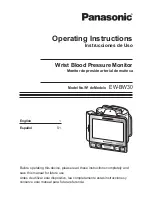
5
Blood Pressure Sensor Specifications
Calibration
slope:
64.64 (mm Hg/V)
intercept:
–32.32 (mm Hg)
Pressure range:
0 mm Hg to 258 mm Hg
Maximum pressure without permanent damage:
1550 mm Hg
Typical accuracy:
±
1 mm Hg
Temperature compensated:
–20°C to 85°C
Sensing element: SSCMRRN005PGAA5
Combined linearity and hysteresis:
typical ±0.25%
Response time:
1 millisecond
Adjusting the Pressure Release Valve
The pressure release valve is set to release at a rate of 3.0 mm Hg/second on an arm
of 32 cm in circumference. For arms much larger or much smaller it may be
necessary to adjust the valve so that the exhaust rate stays in the range of 2.0–
4.0 mm Hg/s. With the bulb in hand and the hose leading away from you, place a
screwdriver into the metal slot on the top of the release valve. To increase the rate of
exhaust, turn the screwdriver clockwise. To decrease the rate of exhaust, turn the
screwdriver counter-clockwise. The larger a subject’s arm the slower the release
valve will exhaust.
Calculating Blood Pressure (Oscillometric Method)
The oscillometric method is a non-invasive means of measuring blood pressure. It is
based on the principle that blood pumped through the arteries by the heart causes the
arterial walls to flex. When a cuff (placed around the upper arm to occlude the
brachial artery) is inflated and then slowly deflated at a constant rate, an arterial
pressure pulse forms. These pressure pulses pass from the arteries, through the arm,
and into the pressure cuff itself.
When the artery is fully compressed, blood flow stops along with the pulsations. As
the pressure in the cuff is slowly decreased, the arterial blood pressure increases to
the point that blood is forced through the artery in short pulses. As the pressure in
the cuff continues to decrease, more blood flows through the occluded artery and the
pulses become increasingly significant until maximum amplitude is reached. Further
decrease of the cuff pressure minimizes the occlusion of the artery and the pulses
continue to decrease until the occlusion is removed.
6
Cuff pressure measured by sensor
These pressure pulses, when separated from the decaying mean pressure of the cuff,
form an oscillating waveform (see figure below). The peak-to-peak amplitudes of
this waveform create a bell shaped “envelope”. Within the envelope, the amplitudes
of the waveform increase through the systolic blood pressure and continue increasing
until the mean arterial pressure (MAP) is reached. Physiologically, the cuff pressure
corresponding to the maximum amplitude approximates the mean arterial pressure.
Generally, the systolic blood pressure is calculated by determining the point along
the envelope prior to the MAP using a known percentage of the maximum
amplitude. Diastolic blood pressure is calculated using the same method and the
portion of the envelope following the MAP.
Oscillatory waveform used to create “Envelope”
Using the BPS at High Altitudes (above 6,000 ft)
To record proper measurements at altitudes above 6,000 ft (0.8 atm or 609 mm/Hg)
the pressure release valve will need to be readjusted. The pressure release valve is set
to release at a rate of 3.0 mmHg/s at sea level, where atmospheric pressure is 1 atm
or 760 mm/Hg. At higher altitudes, the pressure release valve will exhaust at a
slower rate. To use the Blood Pressure Sensor at altitudes above 6,000 ft, open the
pressure exhaust valve by turning it a half turn clockwise. See the instructions above.
Verify that the exhaust rate is now in the range of 2.0–4.0 mmHg/s after making the
adjustment.





















